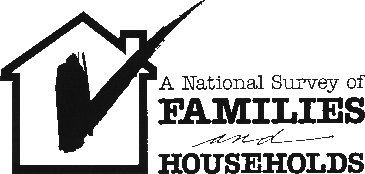Where are the survey instruments?
The survey instruments for NSFH1 and NSFH2 are on the web pages labeled
"Codebook and Data Files" under a heading called "Interview
Schedules". All interviews for NSFH3 were conducted over the telephone
using CATI (computer-assisted telephone interviewing) technology. These
files will not be publicly available. For more information on NSFH3 please
read the field report located at: (fieldreport.doc).
I'm having problems with age variable discrepancies
between NSFH 1 and NSFH2.
We have recognized errors in the respondent's age in NSFH1. The NSFH2 age data
is more reliable.
How can I obtain skip maps?
Skipmaps are now available for NSFH1 and NSFH2 on the "Codebook
and Data" web pages. We do not have them for wave 3.
I need citation information for NSFH1 and NSFH2.
The wave one citation is:
"The Design and Content of The National
Survey of Families and Households." (NSFH Working Paper #1) James
Sweet, Larry Bumpass, and Vaughn Call 1988.
The NSFH2 citation is:
James A. Sweet
and Larry L. Bumpass, The National Survey of Families
and Households - Waves 1 and
2: Data Description and Documentation. Center for
Demography and Ecology, University
of Wisconsin-Madison (http://www.ssc.wisc.edu/nsfh/home.htm),
1996
The NSFH3 citation is:
James A. Sweet and Larry L. Bumpass, The National Survey of Families
and Households - Waves 1, 2, and 3: Data Description and Documentation.
Center for Demography and Ecology, University of Wisconsin-Madison
(http://www.ssc.wisc.edu/nsfh/home.htm), 2002.
Where are the interview date variables for NSFH2?
The interview date variables are in MR33, MR34 and MR35, columns 5255-5260.
Where can I find constructed variables on income
measures for NSFH3?
No variables on income measures have been constructed for NSFH3. Only waves
1 and 2 have such variables.
Does NSFH have Marlowe-Crowne Social Desirability Scale?
No, NSFH does not have this scale.
How to calculate the century months if the event dates are after January 2000?
Conversion Formula for an event date after January 2000:
cm = ((year-1900) * 12) + month
For example:
June 2001 would be calculated like this
(2001-1900) * 12 + 6= 1218
For a table of century months from 1900 to 1999, see Appendix G in wave 1.
Are there variables available for use with SUDAAN,
and if so, how can I get them?
Yes, these variables are available. The file, (sudaan.dat)contains
Stratum, PSU and LA information for each of the NSFH respondents.
sudaan.doc (sudaan.doc)contains
format information for sudaan.dat. Please send e-mail to NSFHHELP
(nsfhhelp@ssc.wisc.edu) if you have questions concerning these
files.
I've read the instructions for retrieving files and
obtaining data, but I still don't understand how to download them.
We now have a link, "Web-Accessible Data", which takes you to
Nesstar. Through Nesstar, a data publishing program, you will be able to
download data in the format of your choosing.
1. From our webpage: (http://www.ssc.wisc.edu/nsfh/) click on the link
that says "Web-Accessible Data".
2. Click on the tab on the left side of the screen that says "National
Survey of Families and Households".
3. Select the wave you are interested in and click on the tab directly
to the left of that wave.
4. Once you have selected the wave of data you are interested in, click
on the icon that looks like a computer disk located in the top right corner
of the screen. From this page you will be asked to sign in as a user. Once
you are recognized as a user you can then download data and/or a codebook,
in the format of your choosing. It can take a couple days for your user
name and password to be recognized.
Here's a quick-step method for downloading data files in text format via
our web site.
1. Once you have read the introductory files, simple go to the "Codebook
and Data Files" web page and save the data file you are interested in.
2. You can use either the codebooks or the "layout" files to
find variable names and column locations to read in the data
How do I read the final weights in NSFH2?
The following is an SPSS printout of the NSFH2 final weight variables:
data list file=a record=1
/1 ID  1-5
(A)
MUFINW93 1870-1877 (A)
MUFIND93 1992-1997 (A)
Print records=1
/' ID ' MUFINW93 ' MUFINW93 ' MUFIND93 ' MUFIND 93
EXECUTE
05040 MUFINW93 .5225300 MUFIND93
52253
09912 MUFINW93 1.122330 MUFIND93
112233
11969 MUFINW93 .6263900 MUFIND93
62639
Reading MUFINW93 and MUFIND93:
file handle a/name='PROJDISK19:[215067.DATA]DRCONST.003'
data list file=a record=1
/1 ID 1-5
(A)
MUFINW93 1870-1877 (8)
MUFIND93 1992-1997 (5)
SELECT IF((ID EQ '05040') OR (ID EQ '09912') OR (ID EQ '11969')
OR (ID EQ '13965') OR (ID EQ '18566') OR (ID EQ '21595'))
LIST VARIABLES = MUFINW93,MUFIND93
MUFINW93 MUFIND93
.52253000 .52253
1.1223300 1.12233
.62639000 .62639
.45753000 .45753
.53487000 .53487
1.0923700 1.09237
Frequencies variables=mufinw93/format=condense
